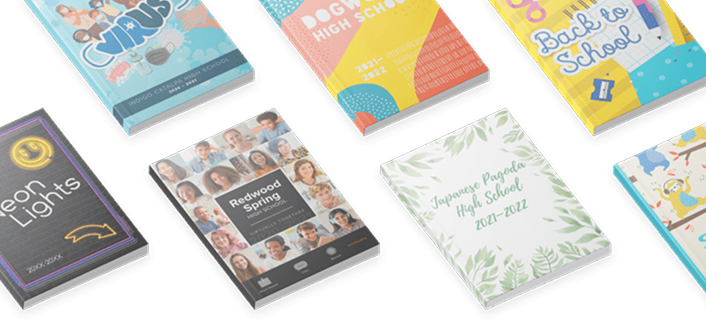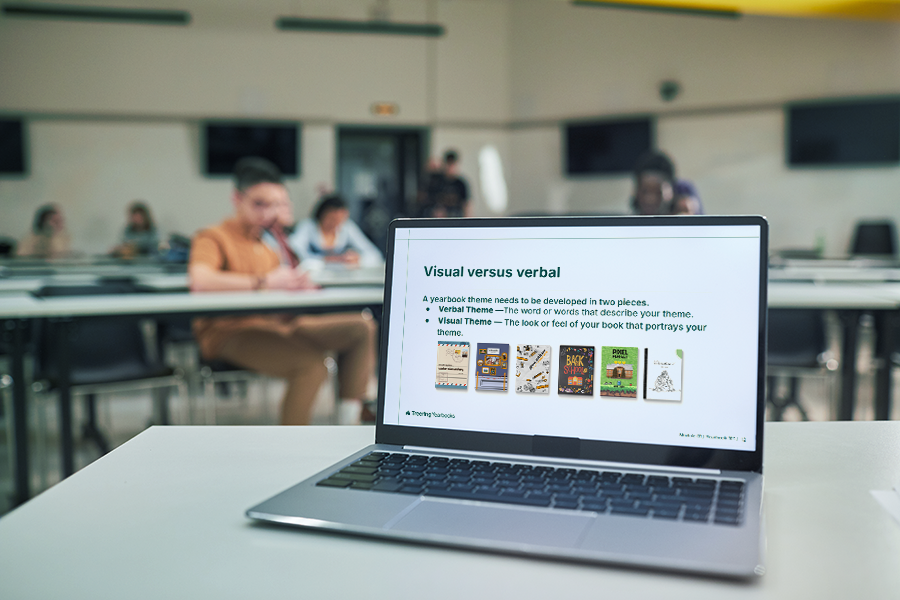Most popular
Subscribe to our blog
Most recent

Caption this: writing tips for yearbook
Yearbook captions provide the context and information to help tell the story behind each photo. They explain what's happening, who is in the picture, and why it's significant. Without captions, many images may lose their meaning or context. Conversely, it is not a storytelling photo if you cannot write about it.
Try this: open your middle school yearbook and try to name all the people on page 24. Can you do it without looking at the captions?

Three types of yearbook captions
Ident captions
Also, called ID captions, they do just that: identify who is in the photograph. Often used in photo collages, ident captions preserve the names of individuals for posterity and historical record. At a basic level, knowing the names of the individuals can make the yearbook content more personal and relatable, and, from a student’s point of view, their name equates to their mark on your campus community.

Summary captions
These captions tell a brief story or narrative related to the photo. They engage the reader by presenting the photo as part of a larger, unfolding story by answering who, what, when, why, where, and how in a sentence. Summary captions are always written in the present tense.
Start by being Captain Obvious and use the why and how to give readers more information.

Expanded captions
Writing an expanded caption for a yearbook involves providing more context and detail about the photo. It’s journalism. It requires practice. It’s a skill. Each expanded caption is a three-sentence story that adds depth to your spread and supports the whole year’s narrative.
Expanded captions have three parts, four if your yearbook has a lede.

How do I write expanded captions?
Because writing is a process, each of the following steps takes time and attention to be effective.
Step 1: observe and analyze the photograph
Identify key elements, people, objects, and actions using who, what, when, why, where, and how. Be sure to consider the emotions, expressions, and details within the foreground and background of the image.
Verify names and activities before moving to the second step.
Step 2: prepare interview questions
Use open-ended questions to gather more information, opinions, and insights from individuals. Find out what happened before and after the photograph and the relationships between the people in the image. Remember, it’s better to have to cut down content than scramble to fill space.
The goal of your interview is to provide additional context and meaning. Showing up and saying, “Give me a quote for the yearbook,” isn’t going to achieve that.
Step 3: put it all together

What not to do
Avoid editorializing and jokes. It’s not your job to critique what is happening (Romero’s awesome painting) or change the narrative (Is that Bob Ross? No, it’s Ezekiel Romero). Your job is to report. Quotes should be used to convey the feelings or reactions of the people involved.
Get more caption help with the writing module in Treering's free curriculum.
By adding captions—ident, summary, or expanded—you not only describe the photo, but also provide a deeper understanding of the moment and its significance, making your yearbook more engaging and informative.

Why you need evergreen content for yearbook
Like its namesake, evergreen content stays fresh for a long time, unlike the tie-dye loungewear we are still trying to forget. While you should definitely include polls and trends in your yearbook (it is the story of the year after all), open-ended interview questions (such as the 40+ we are giving you below) should remain in your repertoire for three reasons:
For ease of use, we organized these interview questions by yearbook section. Grab your editorial team and create your list!
Student Life
Because some of your formative moments occur outside the classroom, be sure to include all that goes into the school day.
Campus Life
Routine
People
These questions make great sidebars to go along your portrait pages.
Milestones
Interests
Academics
Athletics
Bonus: Trending Topics
Add content on the following to complement the evergreen content in your yearbook.
For even more interviewing tips, check out the yearbook storytelling module from Treering's free curriculum.

Selling yearbook ads? Read this first
If you’re considering whether selling yearbook ads is right for your staff, you’re probably looking to take your team to the next level. Of course, it might also mean you’re hoping to satisfy a financial obligation to your yearbook publisher.
Yearbook ad sales can represent a fantastic learning opportunity. This process can empower your students with real-world skills, from pitching to potential clients to designing captivating advertisements. And the proceeds that come from selling ads to parents and local businesses can help offset or even eliminate the cost of many wish-list items.
However, if ad sales are necessary to offset yearbook debt instead of a way to benefit your program, Treering can help.
Define your goal
Before you think about ad sales, ask yourself: what’s our objective? Generally speaking, schools sell yearbook ads for one of four reasons:
- To teach business skills (sales, advertising, negotiation, and more)
- To purchase new equipment
- To help students pursue related learning opportunities
- To pay back existing yearbook debt
If your aim aligns with the first three, congratulations! Purchasing hardware and software that, in your staff's well-trained hands, will enhance your program for years to come is a fantastic achievement. And being able to do so self-sufficiently is even better! If you find yourself here due to the last reason, however, read on.
Cultivate favorable terms
There are many reasons your yearbook organization could be in debt. Perhaps you bought too many books last year (tip: not every company requires a minimum order quantity). Maybe unexpected charges surfaced on your final invoice or your per-book price seems high. Regardless, if ad revenue is solely meant to cover existing debt, it's a signal to reassess terms with your publisher.
The solution? Negotiate more advantageous terms. Open communication with your publisher can often lead to mutually beneficial solutions. Many publishers are willing to collaborate to foster goodwill and ensure continued revenue.
If renegotiation proves challenging, consider evaluating other publishers. Look for a partner that offers flexible terms, never requires contracts or minimum purchase requirements, provides inclusive per-book pricing without hidden fees, and offers school-friendly ways to raise funds.
Selling yearbook ads: the potential of your program
Your yearbook has the potential to not only capture memories but also generate revenue for your program. If you find it becoming a financial burden instead, it's a cue to reassess your strategy. Selling yearbook ads should be a positive venture, enhancing your students' skills and contributing to the success of your yearbook program. As you embark on this journey, keep the focus on empowerment, learning, and the enduring impact your yearbook can have on your school community.
Adviser advice: keep, change, stop
If starting the year with a yearbook debrief wasn’t possible or 3rd period publications popped up on your schedule the day before school started, start here. Keep, change, stop is a conversation to have as a team. Thumb through the yearbook, project some spreads on the wall, and complete a matrix. What aspects of your program are proverbial home runs and should be keepers? What needs to be changed? (Remain proactive and brainstorm solutions.) What needs to be stopped? At TRL 23, we sat down with four advisers to learn their takes.
Watch the full interview on Treering’s Facebook page.
Katie Thomas, Elk Grove, CA
We first met Katie Thomas when she became the yearbook coordinator for her daughters’ K-8 school midway through the year. As the lone parent volunteer, she sold 60 yearbooks in a week and now oversees the middle school club.
For Thomas, cover contests are a keeper. She said each year the school has a theme and she loves how the yearbook club chooses to “intertwine” it with the theme they select.
Moving forward, she’s going to change up the interview process for students in favor of more journalistic writing. “We want to make sure that there are more voices heard,” she said. “This is a student-produced yearbook.”
This year she stopped having multiple editors share a spread. “I learned the hard way,” she said about having students edit each other’s work without a formative peer editing process.
Janet Yieh, San Francisco, CA
Like Thomas, Janet Yieh began as a parent volunteer. Now, she’s transitioned the club from an after school activity to a school day program with 19 middle schoolers.
For the foreseeable future, Yieh will keep giving away yearbooks. Last year it was 100. “We are in San Francisco, and it's an urban environment. We have many families who qualify for free and reduced lunch,” she said. To ensure all eighth graders leave with a yearbook, she adds a small fundraiser to the cost of each book and pushes Treering’s early discount. Since many families take advantage of the sale, Yieh “buys into every single fundraising dollar.” To distribute the books, she creates a contest to win a yearbook so no one is singled out.
She is going to change up the class structure by inviting more experts to share with the club and creating some lesson plans for her students. Last year Yieh piloted this idea with her boss who went to design school. This year, an English teacher will guest teach on writing. “I'm a mom. I'm not a teacher,” said Yieh. “I'm trying to personally create curriculum for them to follow each week.”
While Yieh’s students led the design concept, she’s stopping their theme-less tradition. “If we create a foundation, it will be much easier when it's time to actually pop the photos into their pages.”
Chris Frost, Hemet, CA
“I was a student editor on this exact book, which I'm super proud of,” Christ Frost said. Because he knows the value of ownership, he keeps the tradition of a student-led yearbook program. “Our students decide everything. They pick our theme. They pick and design our layouts by hand because they like to struggle and fight with what a design should look like.” He and co-adviser Billy Valenzuela advise by keeping students on track towards their deadline.
The big change is how Frost’s students will increase representation in their yearbook. Historically, the team at West Valley High covers 80% of students beyond their school photo. That’s not enough. In repose, they created a B.O.L.O. (be on the lookout) wall with “ASB’s Most Wanted” using their coverage tracker. “It's also going to help us see who are those people that are hiding in the shadows that are in that background,” Frost said.
“This is their memory. This is their keepsake. This is a historical document. This is something that 10 years from now, 20 years from now, 30 years from now, they're gonna pull out and show family and there's nothing worse than opening that book up and your kid going, but where are you?”
Chris Frost
He stopped the way students received page assignments: instead of individual assignments, they are now in teams. Each team of five, led by one editor, works on five spreads at a time. Frost said, “They can delegate amongst each other… so it gives kind of a broader range on the pages.”
Beth Stacy, Huber Heights, OH
As a class adviser, Beth Stacy knows how much work her students do to identify each featured person in a photo, write body copy and captions, and place it beautifully in an effectively designed layout.
Without hesitation, she would keep grading spreads. “Every grade or every spread is graded on pass/fail,” Stacy said. The end goal of having all spreads submitted to Stacy print-ready means students are in control of their grades.
Stacy said, “Probably 95 to 98% of our book is taken by one parent who has kids in a bunch of activities, one teacher who is an amateur photographer, and then our professional photographer.” The yearbook culture change is student photography. She’s motivated by the fresh energy the younger team in her class brings.
Stopping the blend of chronological and traditional coverage is top of her list. After trying it for their 75th anniversary book, she said, “It got messy and didn't work very well.” Focusing on the traditional sections such as people, student life, and sports will help returning students train new ones and also balance the load for the few dedicated computers they share.
For more from these advisers, including their tips for getting started, favorite Treering hack, and application processes, watch the full video on Facebook.

3 content ideas for portrait pages
When “outsiders” think of yearbooks, they imagine little beyond the portrait pages. They see the obligatory blue background and big grins that accompany a moment in time many of us, as students, dreaded. (C’mon, we all didn’t receive the Glamor Shots by Deb experience!) Since this is a part of students’ permanent record, it's a necessary component. It is a part of the historical record of the school year. It’s also not our students’ favorite. Long ago, this adviser decided to decrease the size of yearbook portraits, while increasing specialized content. Here are three ideas to break up your portrait pages by adding rich, personal content.
1. By the Numbers
Use stats and surveys to provide a quantifiable portrait of the students pictured on your pages. Begin by understanding what is important to your students and then ask questions. For example, if your school’s focus is on health and wellness, break down how students and staff contribute to that goal by including content such as
Pair the numbers with photographs of students engaging in the activities and quotes for an even more personal approach. What does it mean to be a part of a community so encouraging of physical activity? How do students balance their school work with tournaments and performances?

2. Keep Content Class-y
Grade spreads in your portrait section are ideal for academics or class-specific coverage. Highlight the unifying aspects of school life, such as class trips or advisory periods, and then ask students about their individual experiences with each. Grade sections could also include:
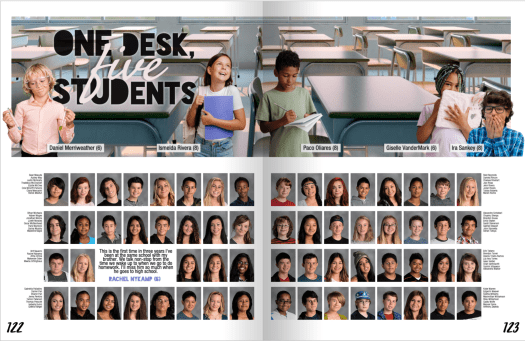
3. Get Personal with Portraits
Personality profiles and student life modules both create opportunities for an inclusive yearbook by targeting lesser known students or students with interests outside school-sponsored arts and athletics. These content modules add voices to the portrait section of your yearbook!

Take advantage of the additional space you'll create by shrinking portraits to pull out more content from your student body.
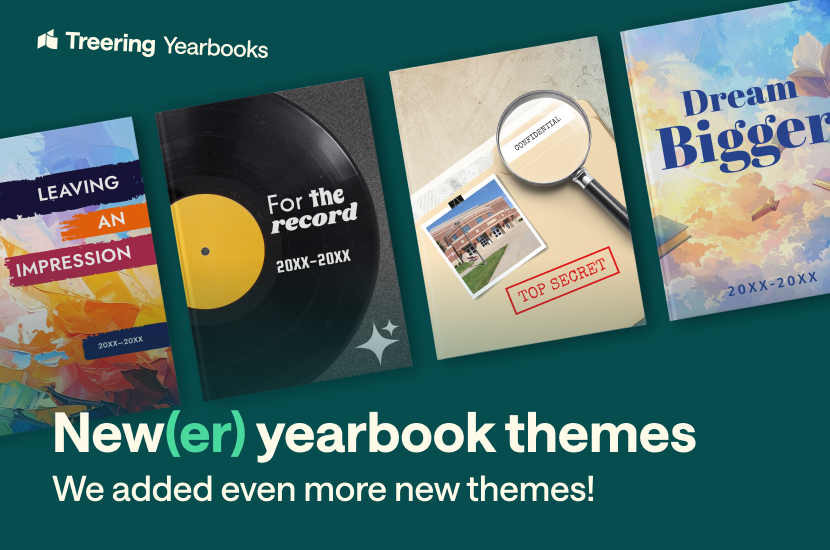
4 Storytelling yearbook themes
A yearbook theme isn’t just layout, graphics, fonts, and a color palette. It’s about storytelling. A developed theme goes beyond the visual, guides your coverage decisions, and sets the tone for the book.
Treering’s design team listened to many schools’ stories during their spring focus groups. The first wave of themes reflected the visual package most schools wanted. This second one expands to add the verbal.
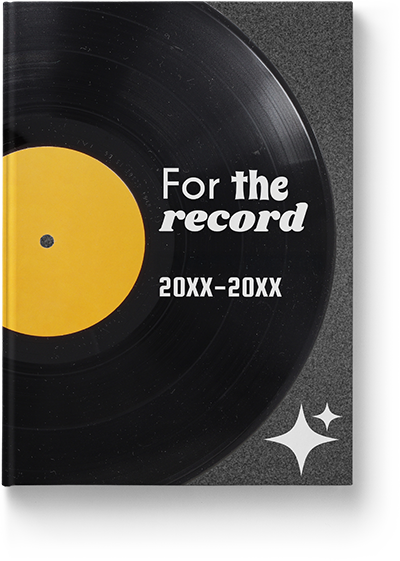
For the Record
Exploring decades from the 1950s to the 1990s, “For the Record” taps into nostalgia. With a two-page style guide of decade-specific graphics, colors, and fonts, yearbook teams can create their own “greatest hits” of the school year.
Adding storytelling elements such as student-created playlists or superlatives presented as album covers will make your memories feel like an anthology.
Additionally, the focus groups of middle and high school advisers asked for less busy backgrounds and more texture. Usually, people would balk at "just" two backgrounds. However, having these consistent threads is why each section works as part of the whole.
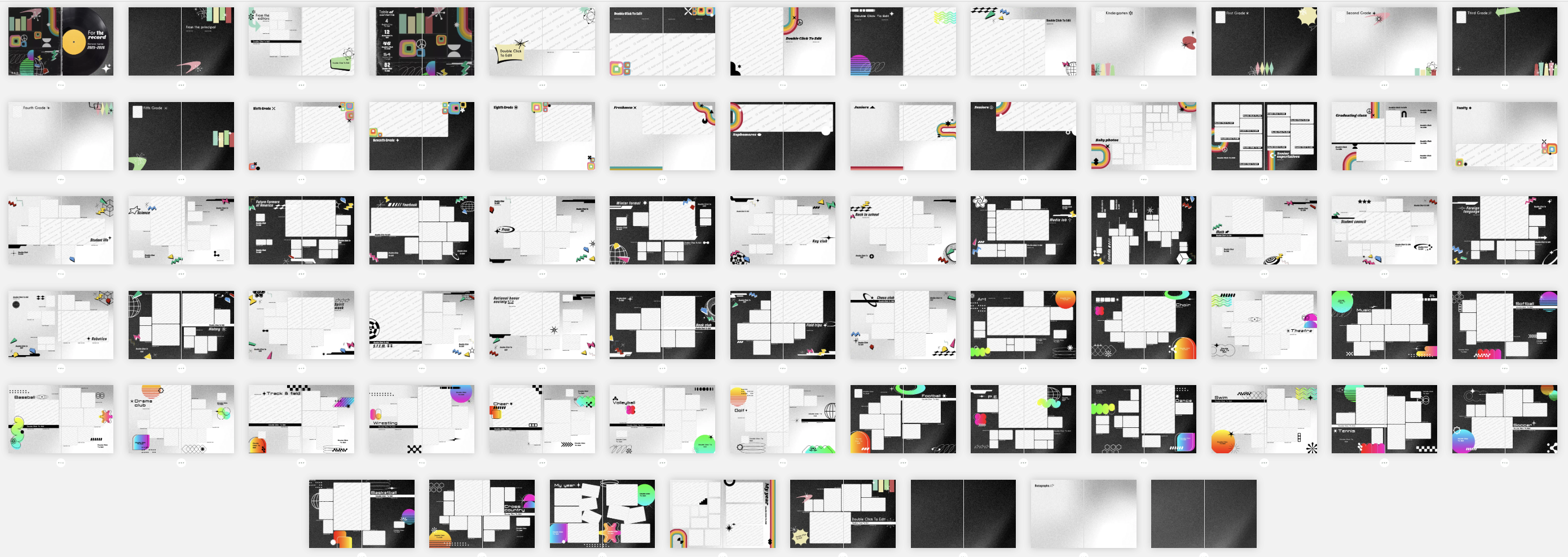
Focus group participants also wanted layouts that emphasized hierarchy and had room for captions and copy. The design team gave yearbook teams this plus flexible options within this theme. They can
- Differentiate sections of the book by decades
- Use one decade to create their own throwback look

Top Secret
The declassified look at the school year is one of the most powerful storytelling mechanisms:
- Showcase hidden gems on campus
- Use photographic clues on divider pages to make small things part of something bigger
- Deconstruct campus happenings with “mission report” sidebars

This theme builds on collage-style design elements—stamps, photo frames, textured backgrounds—but updates the look with a contemporary aesthetic. It draws from the mission vibe while keeping the layouts approachable and fun. And it works for any level of school:
- Elementary school: use playful stamps, oversized labels, and bright textures to highlight classroom memories and fun facts
- Middle school: lean into detective-style layouts such as “case file” spreads on clubs and activities
- High school: take a sleeker approach with dark backgrounds, sharp typography, and subtle textures that nod to spy dossiers without feeling gimmicky
Students will feel like they are all in on the secret together.
(Yes, this theme inspired our team: we applied some of the elements to National School Yearbook Week 2025’s programming.)
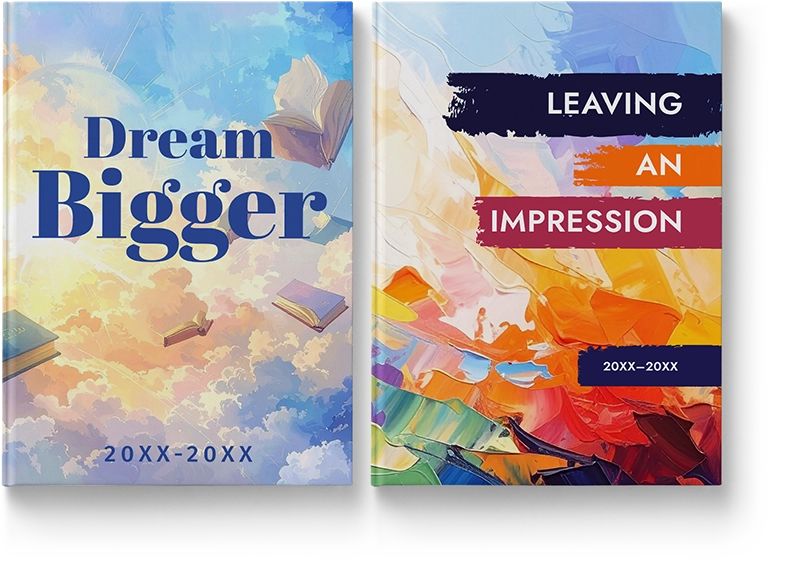
Dream Bigger and Leaving an Impression
Another focus group finding is the appeal of art styles as visual themes. The design team introduced “Gallery” in the first wave, followed by two artistic takes, “Dream Bigger” and “Leaving an Impression.”
The powers that be at Pantone called out neutrals and soft naturals for the Color of the Year 2025. The “Dream Bigger” theme leans into this popularity, offering soft washes of color and flowing shapes that stand in contrast to the textured, thicker brushstrokes of Impressionist paint used in “Leaving an Impression.”
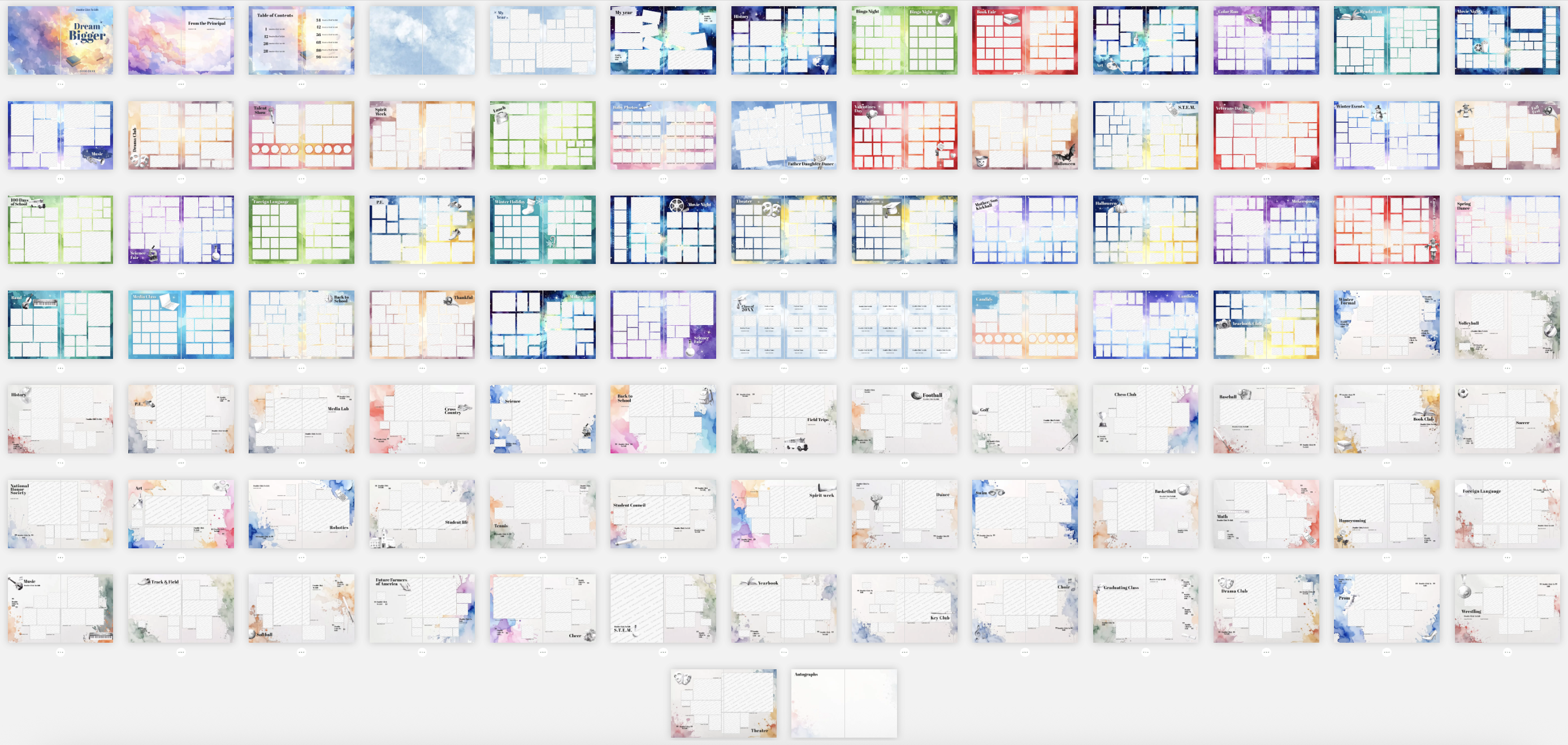
Whereas “Dream Bigger” is ethereal and reflective, “Leaving an Impression” is bold and dynamic. It’s a theme designed with flexibility in mind, especially for K-12 schools.
For younger grades, it offers high-collage layouts that make it easy to include as many students as possible while keeping the design polished. For upper grades, it supports modular design, which means layouts can be broken into smaller, contained units of coverage. With modular design, every spread can tell multiple stories at once, building a richer picture of school life.

Both of these artistic themes make the perfect canvas for seeing how this year is part of a larger journey.
Student stories and voices matter. Your yearbook theme should provide a lens through which your readers can examine them. Treering can help with a collection of over 200 pre-designed themes.

5 yearbook fundraising ideas
Because we want our students to have the best equipment and experiences, sometimes we have to bring in extra cash. Heads up advisers: if you are looking for yearbook fundraisers to afford your book, stop reading this right now, and jump over to this article and learn how to have a debt-free yearbook program.
Fundraise by selling photos
First, the easiest way to raise money for your program is to use what you have: a captive audience, kids with cameras, and some pre-planned epic events.
1. Sell photos that are not in the book
How many times have you been asked for a copy of a photo your students captured at an event or game? Upload unpublished photos to a photo site and sell digital images or prints to parents and students.
2. Sell photos to local media
Smaller newspapers and local online news outlets will purchase athletics photos, especially in more rural areas. When you make your pitch, make sure you have a portfolio of student work.
3. Sell photo shoots
Another way to help your students build a comprehensive body of work is to offer photo sessions by your top photographers. Newer photographers on staff can assist: hold reflectors, take payment, upload, and retouch photos.
- Senior portrait mini shoots in a park
- Photo booth at Homecoming game
- Family photos at a winter all-school event
Fundraising with coverage
Second, you can add mini-ads throughout your book. These paid partnerships with parents, alumni, and business leaders don’t detract from your content and have the potential to add additional voices to your copy.

4. Page sponsors
In the folio, include a line that says “This page is sponsored by Williamstown Transportation” or “Congrats, Talia and the class of 2022! Love, The Cruz Family.” If you do traditional coverage, page sponsors can include club or athletic boosters whereas chronological coverage can be more event-focused: “QuizBowl Forever! Class of 1968 State Champs.”
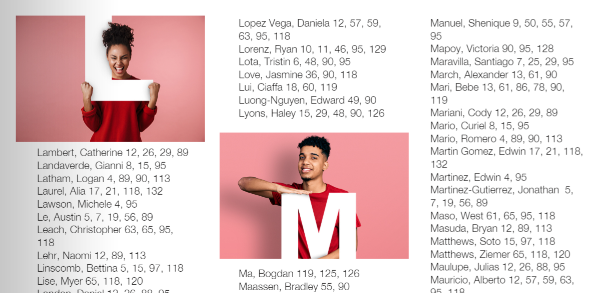
5. Index letters
If you could get 26 more photos in the yearbook, would you? Break up the index with fun portraits of students holding a letter. Some schools auction the honors, others issue letters on a reservation basis. To get the most out of it, compare your coverage report to your buyer list and see which buyers are in the book the least amount of times, offer index letters to those parents first, then go after students who are in the yearbook several times and have yet to purchase one.
Yearbook fundraiser 101: personal and business dds
Advisers use ads to teach business skills: project management, budgeting, and goal-setting. They work with students on talking points and help guide them to the right potential partnerships. It's the quintessential yearbook fundraiser.
Schools with supportive communities tend to do well with business ads. If you’re just getting started, begin by analyzing your area:
- Do you serve a transient population? Partner with realtors.
- Are many parents business owners? Show them how to feature their children in their ad.
- Do you have a bevvy of athletic sponsors? Work with your athletic director to bundle a stadium ad with one with the team photos.
- Are small businesses the norm? Add a business card section.
Whatever you do, don’t try to sell yearbook ads just to pay your yearbook publisher.
Remember the fun
Because fundraiser starts with fun (cliché, we know), your strategy should as well. Celebrate all your successes along the way. For some of your yearbook team, this could be scheduling a meeting with a potential sponsor and doing the presentation. For another, it could be selling 20 photos to your district PR agent and landing an internship. Everyone who buys in should reap some reward, even you!

10 reasons we're excited about TRL
Recreating the wheel is exhausting. Having Treering Live (TRL) experts provide all their tips and tricks saves time and energy and brings the fun back to yearbooking. (Yes, yearbook is a verb.) Treering tailored TRL for yearbook volunteers, educators, and aficionados of all levels, offering 18 sessions so you can engage with various aspects of the creative process. In anticipation, we compiled our top reasons TRL is the yearbook event of the season.

1. Leave with a road map
Figuring out how to get started when you're new to the school yearbook is daunting, especially when the person who used to do it is no longer at the school. Learn how to start and finish your yearbook.
Recommended sessions: I’m the Yearbook Coordinator… Now What? and Teaching Yearbook
2. Live event
Real-time sessions mean your questions get asked and answered promptly. Between the live Q&A during each session and the chat throughout, there are plenty of opportunities for shared learning.
Recommended sessions: Ask Us Anything with Treering’s Co-Founder Brady McCue and Keep, Change, Stop
3. Connecting with other advisers
Because two—or four hundred—heads are better than one, working together turns terrifying yearbook mountains into easy-to-approach small hills. TRL is not just about knowledge acquisition; it's about building connections within the yearbook community during National School Yearbook Week. You'll collaborate with fellow yearbook enthusiasts, sharing your triumphs, learning from your challenges, and forging bonds beyond these three days online.
Recommended sessions: Fundraising and Crowdsourcing and Social Media for Yearbook
4. Making a plan
From a ladder and coverage calendar to the next marketing campaign, you’re leaving TRL with concrete steps to make the best yearbook yet.
Recommended sessions: Getting Organized and Creating a Marketing Plan
5. Design inspiration
Yearbook Hero Lauren Casteen introduced us to mild, medium, and spicy design. Wherever you fall on this scale, you will gain an understanding of layout, typography, and color and how to go to the next level. You’ll also be able to help your yearbook team produce robust designs. Because, seriously, no one should yearbook alone.
Recommended sessions: Design 101 and Design 201
6. Three days of training
Joining TRL for one or all 18 sessions is a testament to your passion for preserving the memories and historical record of the school year, one page at a time.
7. cash
Kind of. Because we love a theme, there will be some sort of game in many sessions. Prizes include pizza parties, art supplies, and gift cards for coffee or Amazon.
8. 6+ hours of PD
Treering loves teachers. You’ll see learning outcomes in the session descriptions, and some of us, unabashedly, speak in teacher-ese. We know the importance of pro-grow opportunities. We know how annoying it is when someone reads their slides.
9. The Treering difference
Many schools consider changing their yearbook program and need to see Treering’s software firsthand. Busy schedules make it difficult, so we have four opportunities to dive in.
Recommended session: Live Demo
10. The journey isn’t over
In keeping with our game theme, your next winning move can take the form of weekly posts on the blog, monthly webinars, and 24/7 support with the Help Center. These myriad options allow flexibility in scheduling and enable you to revisit content or learn something new at your own pace.
Share your top moments during TRL: 23 by tagging us on social using @treering (Facebook and X) or @treeringcorp (Instagram and TikTok) using #trl23.
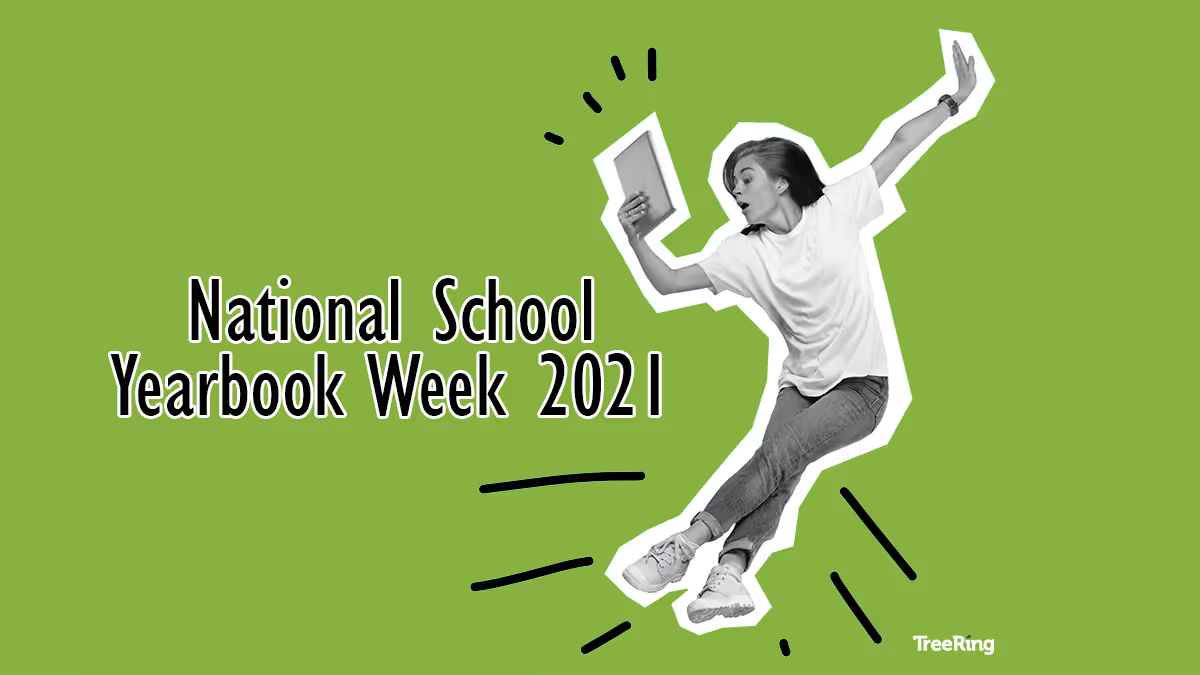
It’s national school yearbook week—here’s how we’re celebrating!
With Proclamation 5703, former President Ronald Reagan made yearbooks even more celebration-worthy by setting apart the first week of October for “appropriate ceremonies and activities” to recognize the creators and the power of a yearbook program. Nearly 30 years later, National School Yearbook Week remains a time to reminisce and a time to look forward.
Monday: celebrate the Heroes
For two weeks, we at Treering have been collecting stories of advisers, grandparents, parents, students, and school staff who make their yearbook successful. From collaborative efforts on original cover designs to timely communication on ever-changing school events, the positive contributions of many are making yearbooks happen.
Treering will announce the winners of the #YearbookHero contest. Schools can celebrate their own heroes by:
- Making banners to post on teacher’s doors to say thank you
- Sharing on social media photos yearbook heroes have shared with your team or a photo of a yearbook hero with a description of why he or she saved the day
- Hosting a pizza luncheon for your yearbook team, because pizza and yearbook are a clutch combo (Was that too cheesy?)
- Decorating your yearbook students’ lockers
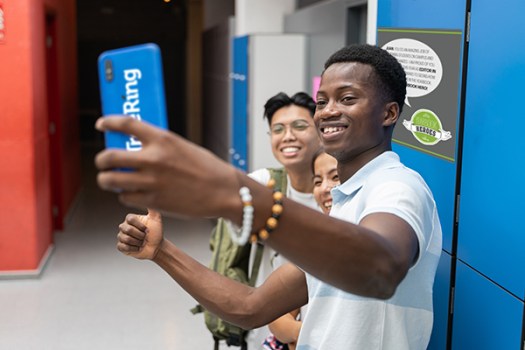
Tuesday: celebrate the product
Just like VH-1’s Behind the Music series, you can do a Behind the Yearbook and showcase the story behind previous years’ themes or a yearbook staff member’s journey. Other fun ways to show off the importance of yearbook on social media include:
- School staff show off their old yearbooks photos
- Highlight important events such as State Championships or famous alumni in previous yearbooks
- Record a teacher or student reading encouraging messages from his/her yearbook
If you haven’t yet branded your book, National School Yearbook Week is the ideal time to do a theme reveal! Some schools make a video to share, others reveal just a theme element or two to tease buyers.
Wednesday: celebrate growth
Mid-National School Yearbook Week, yearbook lovers will unite. For the first time (in forever) Treering is inviting yearbook coordinators and advisers to gather for an epic evening at Treering Live! In addition to breakout sessions for Elementary and middle/high schools, attendees will glean practical ideas on how to
- Sell more yearbooks
- Create an epic yearbook theme
- Overcome common objections
- Take newsworthy photos... on a cellphone
Follow #TRL2021 for Tweetable takeaways your fellow yearbook advisers shared, and work with your team to apply a few this year. We always say, try one or two new things (Treering loves yearbook advisers too much to let you try and do it all!)
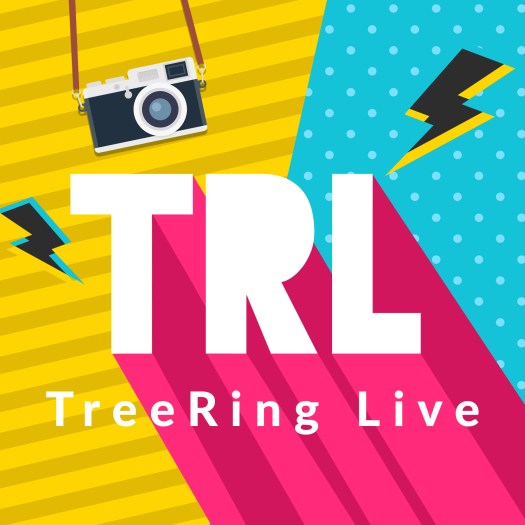
Thursday: build on the momentum
Now that a few days were filled with celebration, take some time to use National School Yearbook Week to propel your team. Collectively, identify what is going well and why. Check your progress towards your goals for the year and ask:
- What is working?
- What needs improvement? How can our strengths help in this area?
- Do we need to refine any goals?
- How will we celebrate reaching our goals?
Schools that see success with goal-setting and achievement monitor progress and also make their goals attainable. Instead of sell more books, try something like if we increase our yearbook sales by the end of December, we will have an ice cream party when we return to school in January.
Fri-yay: #feelgoodFriday
You celebrated. You learned. You strategized. As you prep for some #weekendvibes, take one more opportunity to build unity among your team. Whether your YB teamis made up of students in an after school club or for class credit, or your shepherd a super squad of parents, create a feel-good moment to close out National School Yearbook Week.
With students, a chain of strength is a way for students to self-assess their team contribution. After a brief period of individual work, the group discussion is where the magic happens: students encourage and build up one another. (Pro tip: get paper in your yearbook theme colors to make your team’s chain.)
Parents too need edification. A quick trip to Dollar Tree for some fun thank yous will go a long way: incense for the wise moms, a skein of yarn for the dad who holds it all together, or a trivia book for the parent who is a lifelong learner. Focusing on the strengths of each team member, and celebrating their individual contributions, created a culture of support. This is key for collaboration.

Never yearbook alone
This is the heart of Treering’s Yearbook Club webinars. Teachers looking for classroom support and parent volunteers looking for a launch pad can find resources and how-tos throughout the school year at no cost.

Synchronous instruction
If you don’t speak teacher-ese (or don’t care to on your prep period), this just means it’s live. This real-time interaction means attendees receive instant responses to their questions. (Full disclosure: occasionally, we divert from the script because the group’s needs demand it.)
Direct access to expertise
See what happens when you bring together staff members from product knowledge, marketing, and community advocacy. No PowerPoint slides. No hypotheticals. All yearbook.
We believe in show and tell
Starting at Treering.com, every webinar shows you how to create, get inspiration, and receive help. We show you how to customize your styles and settings, find marketing materials, and maximize the automations in Treering’s yearbook builder.

Each month, new advisers can join a Getting Started webinar to get an overview of the design and print process. As you progress through your yearbook journey other webinars are available, including Treering Live, our flagship virtual yearbooking event and topical sessions on portrait, advanced design, and theme development.
Your yearbook your way
Yearbook creation isn’t a one-size-fits-all process. Neither are Yearbook Club webinars. We’ll show you all your options to make your yearbook represent your population, from changing up backgrounds to creating custom word art.
The Yearbook Club team releases new Tip Tuesday videos each week on YouTube.
Community
Call it networking, if that’s your thing. In the live chat, attendees exchange ideas and strategies.
On a personal note, I’ve met some yearbook advisers in the chat who have become contributors to this blog, and I’d like to think lifelong friends. We celebrate professional and personal milestones together. Occasionally, family pics pop into my inbox, or we text a timely yearbook meme.
No one else understands what being a yearbook coordinator is like outside this small world. I’m going to seek support from those who do.
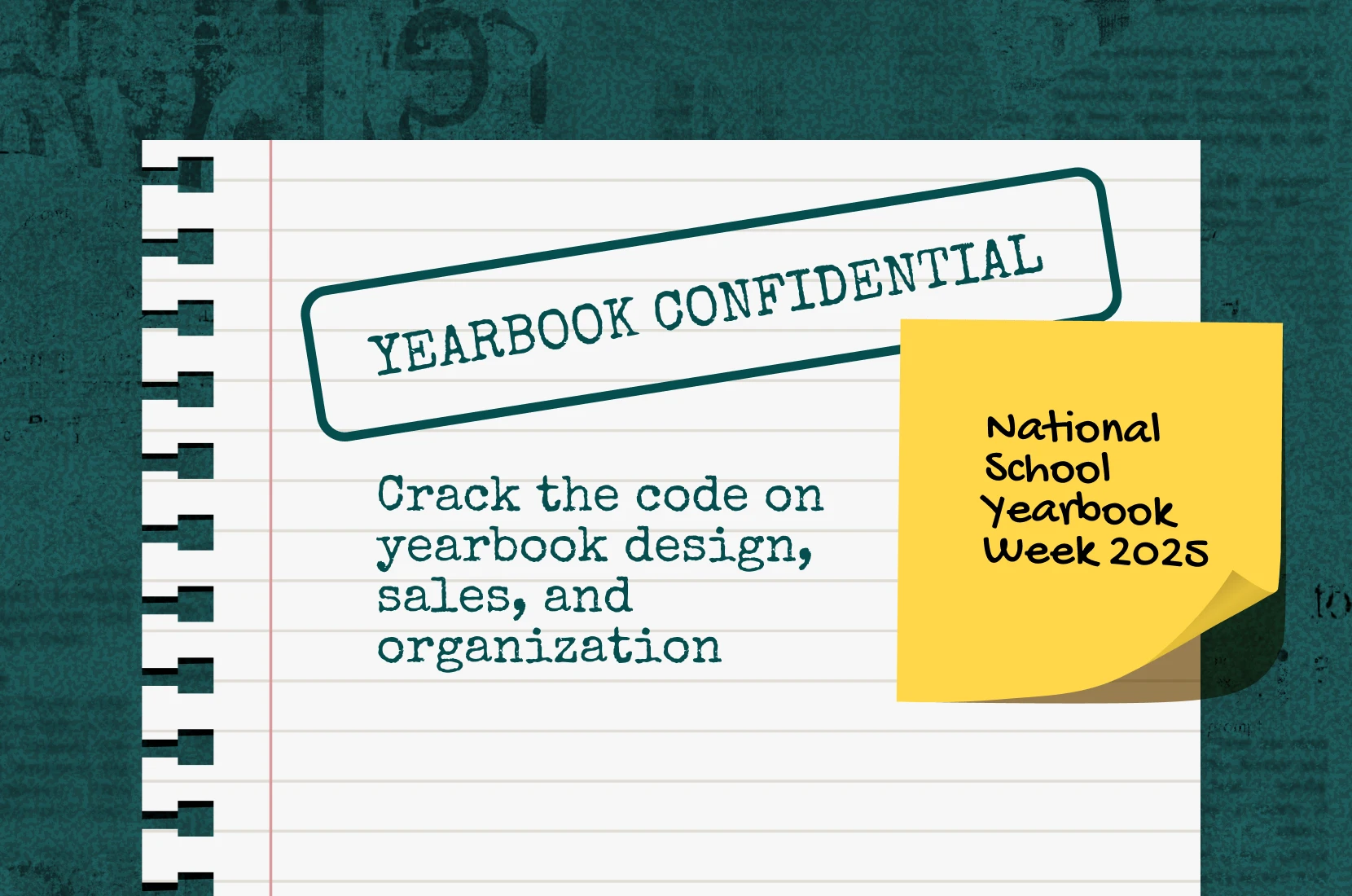
National school yearbook week 2025: ideas to celebrate
With Proclamation 5703, former President Ronald Reagan made yearbooks even more celebration-worthy by setting apart the first week of October for “appropriate ceremonies and activities” to recognize the creators and the power of a yearbook program. Treering intends to do just that during National School Yearbook Week, October 6-10, 2025.
Yearbook confidential: your briefing
Yearbook creators will have declassified access to live training, photo contests, and giveaways. (If you’re super in love with the vibe, check out the Top Secret theme that just dropped for your yearbook.)
Yearbook contests
There are six ways to win: one week-long yearbook Bingo game and five daily Facebook giveaways.
Monday, October 6
Bingo begins. Download your unique bingo card and play along. We’ll “call” words via Meta stories (see them on Facebook and Instagram). The first verified Bingo winner will receive a Canon EOS Rebel T7 DSLR camera with an 18-55mm lens. Get the full Bingo rules here.
Additionally, yearbook creators can share their favorite fall photo to our “Operation Autumn Aesthetic” Facebook photo contest. The strongest storytelling photo will win a $50 gift card.
Tuesday, October 7
Share your insider ideas for photo organization on our daily Facebook giveaway post. HQ (aka Treering’s marketing department) will reward one adviser at random with a $50 gift card.
Meta stories for our week-long Bingo game will continue.
Wednesday, October 8
Another $50 gift card is up for grabs. We want to see your yearbook squad. The most creative team photo wins the daily Facebook post challenge.
If a verified Bingo winner has not come forward, we will increase the calls.
Thursday, October 9
Share your yearbook space, class, or desk on our daily Facebook post for the chance to win. The type-A, TikTok-inspired, and completely unhinged–we want to see them all.
Friday, October 10
Close National School Yearbook Week 2025 with your best sales tips or ideas for a chance to score a $50 gift card on our Facebook post.
Live training
Treering Live (TRL) is Treering’s flagship event. During National School Yearbook Week, TRL will have all the design training, coveted prizes, and organization inspiration that yearbook advisers have come to expect.
What to expect at Treering Live: not-so-top-secret training
With your free registration, Treering Live: Yearbook Confidential features 19 sessions over two days. The programming spans from adviser basics to an interactive photography session. Your mission, should you choose to accept it, is to join HQ for intel, ideas, and a little undercover fun.
The schedule, like Treering, is fully customizable.
Tuesday sessions
1:00 pm PT: Opening session
1:10 pm PT: Session 1 - choose one session to attend
- Top 10 questions new advisers ask
- Yearbook design trends
- Teaching yearbook: curriculum overview
1:50 pm PT: Session 2 - choose one breakout session to attend
- Live demo: portraits
- Adviser roundtable
2:30 pm PT: Session 3 - choose one breakout session to attend
- Photo tips
- Live demo: yearbook style guides
- Getting more students in the book
3:10 pm PT: Session 4 - choose one breakout session to attend
- Anatomy of a yearbook
- Teaching yearbook: theme
3:45 pm PT: Closing session
Wednesday sessions
1:00 pm PT: Opening session
1:10 pm PT: Session 1 - choose one breakout session to attend
- Building your team: yearbook jobs and recruitment
- Treering design tools
- Photo journalism (interactive session)
1:50 pm PT: Session 2 - choose one breakout session to attend
- Yearbook mistakes to avoid
- Live demo: upgrading portrait pages
2:30 pm PT: Session 3 - choose one breakout session to attend
- Top 10 questions parents ask
- Live demo: from good to great
3:10 pm PT: Session 4 - choose one breakout session to attend
- Live demo: page templates
- Teaching yearbook: writing
3:45 pm PT: Closing session
All sessions will be available on the Yearbook Club Replay, so you can re-watch those a-ha moments and catch any sessions you missed through May 2026.
Mission parameters: bingo rules and FAQs
The National School Yearbook Week 2025 Bingo winner must be 18 or older and a Primary Chief Editor or Chief Editor at a US Treering school for the 2025-2026 school year. No purchase is necessary to participate.
By participating, you approve Treering to use your name, write-up, and school name for any marketing purposes, including but not limited to treering.com, social media, and mass media.
1. How do I get my bingo card?
On Monday, October 6, each player will receive an email to download a card. Each one is a unique card with a number. Save your card—you’ll need it to claim a win.
2. How will clues be called?
A third-party Bingo randomizer will randomly select words, which will be announced via Meta stories (Facebook and Instagram) and in the Zoom Events lobby during Treering Live.
3. How do I mark my card?
Print your card or track digitally. Mark off words as they are called.
4. What counts as a bingo?
We are playing classic Bingo: a straight line of five words (horizontal, vertical, or diagonal).
5. How do I claim a win?
Email marketing@treering.com immediately with your name, Treering school, and card number. The first valid email received is the winner.
6. What happens after I email my win?
We’ll verify your card against our called words. The first valid email received is the winner.
7. Can more than one person win?
No, only the first verified winner counts.
8. What if I lose my card?
No problem, just download your card again. You may have missed some words; jump on our socials to get caught up.
9. How many rounds will we play?
There will be one round of Bingo from October 6-10, 2025.
10. What are the prizes?
The winner will receive a Canon EOS Rebel T7 DSLR camera with an 18-55mm lens. Treering will ship the camera directly to the school address associated with the winner’s Treering account.
11. Do I have to shout, “bingo?”
We aren’t going to stand in your way if you want to do the Bingo Boogie. Just remember to be the first to send an email marketing@treering.com with your name, Treering school, and card number to claim the prize.
12. Can I play if I join late?
Yes! All of the words announced via Meta stories will remain for 24 hours. You’ll just start marking from the current clue onward.
13. I’m a content creator. How can I share what I’m doing for National School Yearbook Week on social media?
Tag Treering Yearbooks (@treering on Facebook, @treeringcorp on Instagram and TikTok) and use the hashtags #NationalSchoolYearbookWeek, #NationalYearbookWeek, #YearbookWeek, #YearbookBingo
Social contest rules
The National School Yearbook Week 2025 photo contest winners must be 18 or older and a member of a Treering school for the 2025-2026 school year. No purchase is necessary to participate.
Valid posts must include an original photo. No AI images allowed. By participating, you have verified the approval of others pictured, and you approve Treering to use your name, write-up, and school name for any marketing purposes, including but not limited to showcasing on www.treering.com, sharing on social media, and sharing with media.
The photo criteria will be based on its creativity, relevant emotional impact (humor is more than acceptable), and overall aesthetic appeal.
If you have any questions, contact us at marketing@treering.com.
Nearly 30 years later, National School Yearbook Week remains a time to reminisce and a time to look forward, hopefully with a few wins for you and your yearbook program.

Fall crowdsourcing ideas for student & classroom photos
Starting and finishing strong isn't just for marathons (although advising yearbook sure feels like one at times). The fall months are ideal for beginning the momentum for your yearbook program. From building your team to selecting a yearbook theme, the fall is an ideal time to begin working alongside your school community. Fall in love with these tips to crowdsource more yearbook photos during September, October, and November.
Fall celebration photos to crowdsource
Use the fun “National Holidays” to create dress up days, activities, or even sidebar coverage for your yearbook. Libraries and DEAR Time can be the focus on September 6, Read a Book Day. Photographs of students with their stuffed friends on September 9’s National Teddy Bear Day make for a cuddly sidebar that pairs well within a classroom PJ Day. And let’s face it, nothing says volunteer and teacher appreciation like National Coffee Day on September 19!
Some other fall holidays to use when sourcing photos include:
- World Smile Day on the first Friday in October
- National Coaches’ Day on October 6
- National Reptile Awareness Day on October 21
- National Sandwich Day on November 3
- National STEAM Day on November 8
- National Education Week during the week before Thanksgiving
STEAM Day on November 8 is an opportunity to show students collaborating and also gather the whole picture (pun intended) of a project from ideation to completion!


Source POV photos
Social media continues to be a steady stream of photographs and posts from the perspectives of parents, staff, and students on your campus. Commenting, “May we use this in the yearbook?” is a way to build excitement for the book and encourage a student whose photo is truly worth sharing beyond their social feed. Some Treering schools promote a hashtag that equates reprinting permission and also makes it easy to search for images.
Using photographs sourced from parents, staff, and students adds a layer of authenticity to your yearbook because it involves new perspectives. Consider crowdsourcing photos from
- Fans at athletic events
- The cast and crew of the musical
- Art students and their in-progress works
- Two students snapping the same event, from different angles
- A period of time, such as the prep hours before the Homecoming dance
As always, a call to contribute to the yearbook is also a call to purchase a yearbook. Use these fall events as opportunities to sell yearbooks as well.
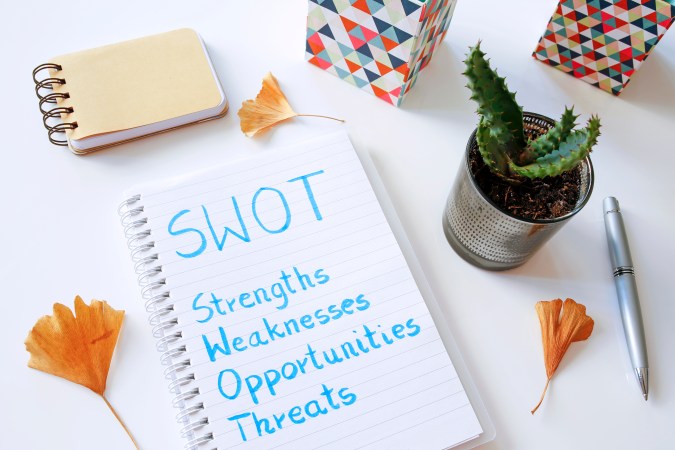

Partner with classroom teachers to source yearbook photos
There are those record-keeping, awareness-raising, champions of academia on campus who photograph student activities. Those are the teachers with whom to connect. (For every teacher-storyteller on your campus, there will be one overwhelmed with the idea of one more thing to do. Know your audience.)
Classroom photos don't always have to be posed group shots of students. Classroom photographs can also include workspace photographs. Flat lays of student and teacher desks or open backpacks offer insight into personality, workstyle patterns, and any quirks. This is also a way to feature those camera-shy campus personalities.
Some teachers choose to incorporate photography in their lessons. You may use the results as a way to showcase student art and cover classroom happenings.

